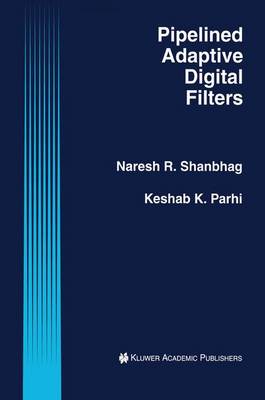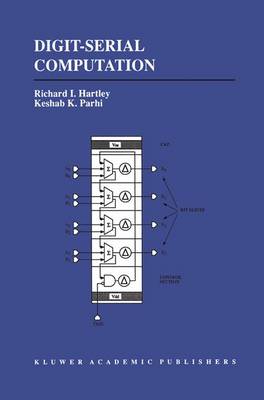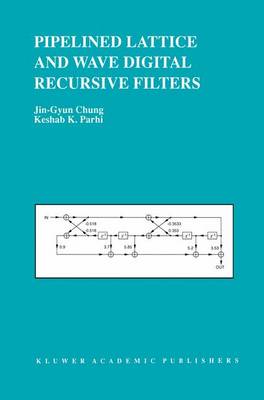The Springer International Series in Engineering and Computer Science
3 primary works
Book 274
Adaptive filtering is commonly used in many communication applications including speech and video predictive coding, mobile radio, ISDN subscriber loops, and multimedia systems. Existing adaptive filtering topologies are non-concurrent and cannot be pipelined. Pipelined Adaptive Digital Filters presents new pipelined topologies which are useful in reducing area and power and in increasing speed. If the adaptive filter portion of a system suffers from a power-speed-area bottleneck, a solution is provided.
Pipelined Adaptive Digital Filters is required reading for all users of adaptive digital filtering algorithms. Algorithm, application and integrated circuit chip designers can learn how their algorithms can be tailored and implemented with lower area and power consumption and with higher speed. The relaxed look-ahead techniques are used to design families of new topologies for many adaptive filtering applications including least mean square and lattice adaptive filters, adaptive differential pulse code modulation coders, adaptive differential vector quantizers, adaptive decision feedback equalizers and adaptive Kalman filters. Those who use adaptive filtering in communications, signal and image processing algorithms can learn the basis of relaxed look-ahead pipelining and can use their own relaxations to design pipelined topologies suitable for their applications.
Pipelined Adaptive Digital Filters is especially useful to designers of communications, speech, and video applications who deal with adaptive filtering, those involved with design of modems, wireless systems, subscriber loops, beam formers, and system identification applications. This book can also be used as a text for advanced courses on the topic.
Pipelined Adaptive Digital Filters is required reading for all users of adaptive digital filtering algorithms. Algorithm, application and integrated circuit chip designers can learn how their algorithms can be tailored and implemented with lower area and power consumption and with higher speed. The relaxed look-ahead techniques are used to design families of new topologies for many adaptive filtering applications including least mean square and lattice adaptive filters, adaptive differential pulse code modulation coders, adaptive differential vector quantizers, adaptive decision feedback equalizers and adaptive Kalman filters. Those who use adaptive filtering in communications, signal and image processing algorithms can learn the basis of relaxed look-ahead pipelining and can use their own relaxations to design pipelined topologies suitable for their applications.
Pipelined Adaptive Digital Filters is especially useful to designers of communications, speech, and video applications who deal with adaptive filtering, those involved with design of modems, wireless systems, subscriber loops, beam formers, and system identification applications. This book can also be used as a text for advanced courses on the topic.
Book 316
Digital signal processing (DSP) is used in a wide range of applications such as speech, telephone, mobile radio, video, radar and sonar. The sample rate requirements of these applications range from 10 KHz to 100 MHz. Real time implementation of these systems requires design of hardware which can process signal samples as these are received from the source, as opposed to storing them in buffers and processing them in batch mode. Efficient implementation of real time hardware for DSP applications requires study of families of architectures and implementation styles out of which an appropriate architecture can be selected for a specified application. To this end, the digit-serial implementation style is proposed as an appropriate design methodology for cases where bit-serial systems cannot meet the sample rate requirements, and bit-parallel systems require excessive hardware. The number of bits processed in a clock cycle is referred to as the digit-size. The hardware complexity and the achievable sample rate increase with increase in the digit-size. As special cases, a digit serial system is reduced to bit-serial or bit-parallel when the digit-size is selected to equal one or the word-length, respectively. A family of implementations can be obtained by changing the digit-size parameter, thus permitting an optimal trade-off between throughput and size. Because of their structured architecture, digit-serial designs lend themselves to automatic compilation from algorithmic descriptions. An implementation of this design methodology, the Parsifal silicon compiler was developed at the General Electric Corporate Research and Development laboratory.
Book 344
Pipelined Lattice and Wave Digital Recursive Filters
by Jin-Gyun Chung and Keshab K. Parhi
Published 30 November 1995
Pipelined Lattice and Wave Digital Recursive Filters uses look-ahead transformation and constrained filter design approaches. It is also shown that pipelining often reduces the roundoff noise in a digital filter. The pipelined recursive lattice and wave digital filters presented are well suited where increasing speed and reducing area or power or roundoff noise are important. Examples are wireless and cellular codec applications, where low power consumption is important, and radar and video applications, where higher speed is important.
The book presents pipelining of direct-form recursive digital filters and demonstrates the usefulness of these topologies in high-speed and low-power applications. It then discusses fundamentals of scaling in the design of lattice and wave digital filters. Approaches to designing four different types of lattice digital filters are discussed, including basic, one-multiplier, normalized, and scaled normalized structures. The roundoff noise in these lattice filters is also studied. The book then presents approaches to the design of pipelined lattice digital filters for the same four types of structures, followed by pipelining of orthogonal double-rotation digital filters, which eliminate limit cycle problems. A discussion of pipelining of lattice wave digital filters follows, showing how linear phase, narrow-band, sharp-transition recursive filters can be implemented using this structure. This example is motivated by a difficult filter design problem in a wireless codec application. Finally, pipelining of ladder wave digital filters is discussed.
Pipelined Lattice and Wave Digital Recursive Filters serves as an excellent reference and may be used as a text for advanced courses on the subject.
The book presents pipelining of direct-form recursive digital filters and demonstrates the usefulness of these topologies in high-speed and low-power applications. It then discusses fundamentals of scaling in the design of lattice and wave digital filters. Approaches to designing four different types of lattice digital filters are discussed, including basic, one-multiplier, normalized, and scaled normalized structures. The roundoff noise in these lattice filters is also studied. The book then presents approaches to the design of pipelined lattice digital filters for the same four types of structures, followed by pipelining of orthogonal double-rotation digital filters, which eliminate limit cycle problems. A discussion of pipelining of lattice wave digital filters follows, showing how linear phase, narrow-band, sharp-transition recursive filters can be implemented using this structure. This example is motivated by a difficult filter design problem in a wireless codec application. Finally, pipelining of ladder wave digital filters is discussed.
Pipelined Lattice and Wave Digital Recursive Filters serves as an excellent reference and may be used as a text for advanced courses on the subject.


